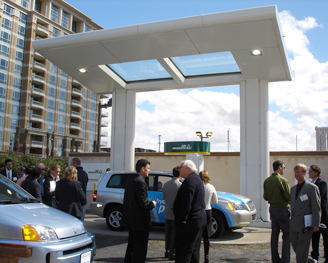UC Irvine Celebrates Grand Opening of Hydrogen Fueling Station
UC Irvine today celebrated the grand opening of its automobile hydrogen fueling station – the first of its kind in Orange County, and the first in California capable of dispensing hydrogen at 700 bar, or 10,000 pounds per square inch, which in some cases can nearly double a vehicle's driving range.
Automakers Toyota, Nissan, Honda, General Motors and DaimlerChrysler are expected to use the station to fuel demonstration vehicles that are not yet commercially available. The station provides the newest in fueling technology to meet the demands of the vehicle development programs.
"The world looks to California as the testing ground for next-generation automobile technologies. The shift to a hydrogen economy is not an incremental change to society, but rather a dramatic and fundamental shift in the way that individuals will operate their vehicles in the future," said Scott Samuelsen, director of UCI's National Fuel Cell Research Center (NFCRC). "UCI has played an integral role in leading this transformation, and we are excited to be taking an important next step with the opening of this state-of-the-art hydrogen refueling station."
The NFCRC and Air Products of Allentown, Pa., designed, engineered and installed the station with funding from the U.S. Department of Energy and California's South Coast Air Quality Management District. The station is operated by the NFCRC and maintained by Air Products. Planning is under way for the addition of a separate liquid dispensing unit that can directly fill vehicles from BMW that carry liquid hydrogen on board as a fuel.
The station features dual-pressure technology that allows drivers to select the pressure at which to refuel their hydrogen vehicles. Fuel cell vehicles can achieve a greater range between refuelings by using hydrogen at higher pressures. Since January 2003, UCI has had the ability to dispense hydrogen at 350 bar, or 5,000 pounds per square inch. Air Products completed installation of a new 350 bar system in August 2006 and added the 700 bar system earlier this month.
The facility looks like a gas station, with stand-alone dispensers that deliver pure gaseous hydrogen at discrete pressures through noninterchangeable nozzles. An electronic screen provides step-by-step fueling instructions, similar to a retail gasoline dispenser. The station has a capacity of 25 kilograms of hydrogen per day - enough for five to 10 fill-ups, depending on vehicle capacity. It takes three to six minutes to fuel a vehicle, at either pressure. The station also can monitor tank temperature and pressure during the fueling process.
Along with providing additional support for the growing number of fuel cell vehicles in Southern California, the station provides opportunities to learn more about fueling system efficiencies, hydrogen demand, fill times, supply and storage logistics, and operator experiences and fill patterns.
According to the California Fuel Cell Partnership, 23 hydrogen stations exist statewide, and 14 more are planned. In all, more than 165 fuel cell vehicles operate in California. Fuel cell-powered vehicles are not yet available for purchase by the general public, as adequate infrastructure does not exist nationwide to support the new technology. But this infrastructure is growing, and automakers have indicated they may begin selling fuel cell vehicles to consumers by 2010.
When used to deliver energy, hydrogen produces zero or very low emissions. The emissions from a hydrogen fuel cell-powered vehicle contain only water vapor. Hydrogen today is produced efficiently from natural gas and also can be produced from non-petroleum sources, thereby potentially reducing the country and state's dependence on petroleum. The ultimate goal is for hydrogen to be produced through a variety of clean and renewable energy sources.
"Hydrogen is emerging as the principal candidate for meeting the needs of next-generation transportation systems in response to two major environmental challenges – global climate change and urban smog. It also addresses the national goal of fuel independence and its inextricable link to national security," Samuelsen said. "Enthusiasm for hydrogen is high because it would allow the public to maintain the freedom of movement made possible by automobiles while addressing these critical environmental and geopolitical challenges."
 First of its kind in Orange County, the facility is acclaimed as a foothold to future
About Air Products:
First of its kind in Orange County, the facility is acclaimed as a foothold to future
About Air Products: Air Products is the world’s largest supplier of merchant hydrogen and is leading the way toward developing the hydrogen infrastructure necessary to fuel hydrogen compressed natural gas and hydrogen fuel cell vehicles. Since 1996, Air Products has installed more than 65 hydrogen fueling stations in 12 countries.
About the National Fuel Cell Research Center: The National Fuel Cell Research Center, dedicated in 1998 by the U.S. Department of Energy and the California Energy Commission, is recognized worldwide. The center was the first university fuel cell research program established in the United States and is recognized as the foremost fuel cell systems research program in the nation.
About the University of California, Irvine: The University of California, Irvine is a top-ranked university dedicated to research, scholarship and community service. Founded in 1965, UCI is among the fastest-growing University of California campuses, with more than 25,000 undergraduate and graduate students and about 1,800 faculty members. The second-largest employer in dynamic Orange County, UCI contributes an annual economic impact of $3.7 billion. For more UCI news, visit www.today.uci.edu.
Television: UCI has a broadcast studio available for live or taped interviews. For more information, visit www.today.uci.edu/broadcast.
News Radio: UCI maintains on campus an ISDN line for conducting interviews with its faculty and experts. The use of this line is available free-of-charge to radio news programs/stations who wish to interview UCI faculty and experts. Use of the ISDN line is subject to availability and approval by the university.
Related Link: Air Products
February 27, 2007